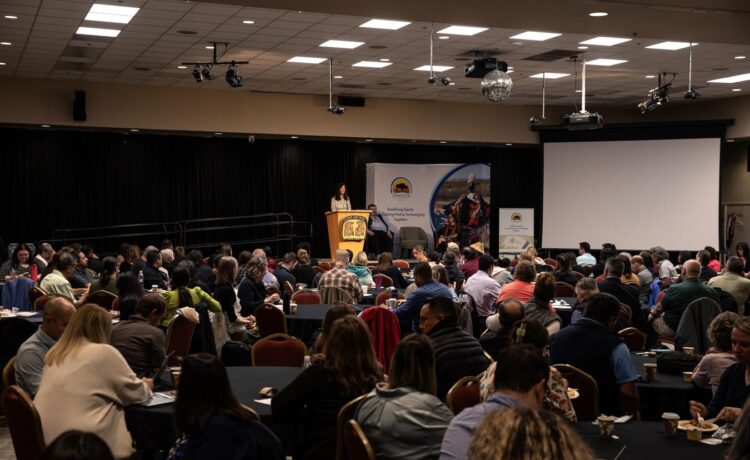In the search for the next frontier of innovation and opportunity, impact investors are increasingly looking toward Indian Country — a dynamic and under-invested market poised for transformative growth. From clean energy and regenerative agriculture to digital infrastructure and housing, Native communities are leading the way with bold, visionary projects that not only serve their people but offer scalable solutions for a changing world.
At Oweesta Corporation, we’ve seen firsthand how Native CDFIs (Community Development Financial Institutions) are unlocking potential in tribal communities by supporting entrepreneurs, building housing, and advancing sustainable infrastructure. These are not charity-driven efforts; they are strategic investments delivering measurable returns — both financially and socially.
Chrystel Cornelius speaking during 2023 Capital Access Convening in Juneau, AK.
Oweesta
Indian Country: A Growing Market of Opportunity
Tribal nations are sovereign governments with growing economic engines. Today, Indian Country spans 574 federally recognized tribes across 35 states, generating over $130 billion in annual economic activity. And that figure doesn’t even capture the full landscape of Indigenous economies — which includes state-recognized tribes, Native Hawaiian communities, and many others exercising self-determination and working toward federal acknowledgment.
Yet, despite this strength, Native communities remain among the most undercapitalized populations in the U.S. Less than 0.4% of philanthropic funding and an even smaller fraction of investment dollars reach Native-led initiatives.
That dynamic is beginning to shift. New investment models — rooted in Native leadership, sovereignty, and community-driven priorities — are reshaping what it means to invest in Indigenous economies. Through partnerships with values-aligned investors like Tamalpais Trust and philanthropic funders like the Northwest Area Foundation, Native communities are building energy sovereignty, supporting Native farmers and ranchers, expanding broadband access, and creating culturally grounded financial education programs.
As Nikki Foster from the Northwest Area Foundation notes:
“Native CDFIs have a proven and successful model for building opportunity in Indian Country. Because they understand the unique assets and the traditional values of Native communities, they can provide pathways for entrepreneurs in ways that grow businesses and employment, even in places without a main street or a bank. And, they have the numbers to back this up. This approach builds healthy tribal and regional economies for the benefit of all.”
“Indian Country is rich with innovation, resilience, and opportunity. For too long, we’ve lacked access to capital — but that’s changing,” says Chrystel Cornelius, President and CEO of Oweesta Corporation.
Indigenous Innovation for a Sustainable Future
The economic growth emerging from Indian Country is deeply tied to cultural preservation and environmental stewardship. Native entrepreneurs are leading solar and wind projects that restore ancestral lands, launching technology ventures that connect rural communities, and expanding food systems that prioritize health and sustainability.
In fact, many of the industries that define the future — clean energy, regenerative agriculture, and climate resilience—are rooted in Indigenous knowledge systems. That makes Indian Country not just a market to watch, but a wellspring of leadership and innovation the world urgently needs.
“When you invest in Native communities, you’re investing in time-tested, sustainable approaches that have served our people — and this planet — for generations,” adds Cornelius.
A Better Return: Long-Term Prosperity for All
Investing in Native communities creates ripple effects far beyond tribal lands. According to Oweesta’s recent impact analysis, every dollar invested in Native CDFIs generates over $2.38 million in local economic impact — fueling job creation, supporting small businesses, increasing homeownership, and building generational wealth.
In addition to social outcomes, investments in Native financial institutions show strong financial performance: low default rates, high portfolio recovery rates, and competitive internal rates of return (IRR) for patient capital vehicles.
“Native CDFIs are more than lenders — we are weavers of prosperity, resilience, and self-determination,” says Cornelius.
Chyrstel Cornelius, CEO of Oweesta and Ronald Milsap, Director, U.S. Zero Barriers to Business with BMO during the awards ceremony at Oweesta’s 2024 Capital Access Convening in Santa Ana Pueblo, NM. BMO was a sponsor for Oweesta’s Capital Access Convening.
Sam Levitan Photography
From Philanthropy to Partnership
Funders and investors are moving away from traditional charity models toward partnership-based approaches — ones that trust Native organizations to lead. This shift includes providing unrestricted funding, investments paired with equity, patient capital, and long-term commitments grounded in relationship, accountability, and respect for sovereignty.
At Oweesta, we work alongside partners who understand that economic justice for Native people is not a peripheral issue — it’s central to building a stronger, more inclusive economy. We have seen firsthand the transformational power of capital aligned with culture, vision, and community priorities.
As Shannon Ward, Chief Lending Officer at Oweesta, affirms,
“At Oweesta, we see firsthand how investments in Native CDFIs transform lives, create sustainable growth, and build generational wealth. We are not just funding projects, we are empowering communities to thrive and lead the way toward a more inclusive and sustainable future.”
The Time is Now
Indian Country is no longer a hidden market — it’s a hot market. With the right investments, tribal nations are poised to lead in shaping a just, sustainable future for all.
For investors seeking real impact, resilience, and meaningful growth, the opportunity is clear:
Partner with Native communities. Fund Native-led solutions. Build the future we all deserve.





